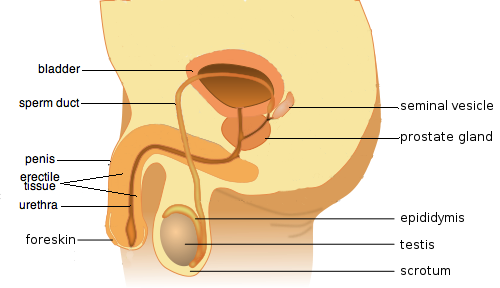Reproduction
6.6.1 Draw and label diagrams of the adult male and female reproductive systems.

Figure 6.6.1 - The male reproductive system

Figure 6.6.2 - The female reproductive system
6.6.2 Outline the role of hormones in the menstrual cycle, including FSH (follicle stimulating hormone), LH (luteinizing hormone), estrogen and progesterone.
The menstrual cycle:
- FSH is secreted by the pituitary gland and its levels start to rise. This stimulates the follicle to develop and the follicle cells to secret estrogen.
- Estrogen then causes the follicle cells to make more FSH receptors so that these can respond more strongly to the FSH.
- This is positive feedback and causes the estrogen levels to increase and stimulate the thickening of the endometrium (uterus lining).
- Estrogen levels increase to a peak and by doing so it stimulates LH secretion from the pituitary gland.
- LH then increases to its peak and causes ovulation (release of egg from the follicle).
- LH then stimulates the follicle cells to secrete less estrogen and more progesterone. Once ovulation has occurred, LH stimulated the follicle to develop into the corpus luteum.
- The corpus luteum then starts to secrete high amounts of progesterone. This prepares the uterine lining for an embryo.
- The high levels of estrogen and progesterone then start to inhibit FSH and LH.
- If no embryo develops the levels of estrogen and progesterone fall. This stimulates menstruation (break down of the uterine lining). When the levels of these two hormones are low enough FSH and LH start to be secreted again.
- FSH levels rise once again and a new menstrual cycle begins.
6.6.3 Annotate a graph showing hormone levels in the menstrual cycle, illustrating the relationship between changes in hormone levels and ovulation, menstruation and thickening of the endometrium.
6.6.4 List three roles of testosterone in males.
Roles:
- Stimulates the development of prenatal genitalia.
- Stimulates the development of the male secondary sexual characteristics such as growth of the skeletal muscle and pubic hair.
- During adulthood it maintains the sex drive.
6.6.5 Outline the process of in vitro fertilization (IVF).
Process:
- For a period of three weeks, the women has to have a drug injected to stop her normal menstrual cycle.
- After these three weeks, high doses of FSH are injected once a day for 10-12 days so that many follicles develop in the ovaries of the women.
- HCG (another hormone) is injected 36 hours before the collection of the eggs. HCG loosens the eggs in the follicles and makes them mature.
- The man needs to ejaculate into a jar so that sperm can be collected from the semen. The sperm are processed to concentrate the healthiest ones.
- A device that is inserted through the wall of the vagina is used to extract the eggs from the follicles.
- Each egg is then mixed with sperm in a shallow dish. The dishes are then put into an incubator overnight.
- The next day the dishes are looked at to see if fertilization has happened.
- If fertilization has been successful, two or three of the embryos are chosen to be placed in the uterus by the use of a long plastic tube.
- A pregnancy test is done a few weeks later to find out if any of the embryos have implanted.
- A scan is done a few weeks later to find out if the pregnancy is progressing normally.
6.6.6 Discuss the ethical issues associated with IVF.
|
Arguments for IVF |
Arguments against IVF |
|
Many types of infertility are due to environmental factors rather than genetic which means that the offspring would not inherit the infertility. |
The infertility of the parents may be inherited by their offspring passing on the suffering to the next generation. |
|
The embryos that are killed during the IVF process cannot feel pain or suffering as they do not have a developed nervous system. |
More embryos are produced than needed and the ones that remain are usually killed which denies them the chance of a life. |
|
Suffering caused by genetic diseases can be decreases by screening the embryos before placing them into the uterus. |
Embryologists select which embryos will be placed into the uterus. Therefore they decide the fate of new individuals as they choose which ones will survive and which ones will die. |
|
Since the IVF process is not an easy one emotionally and physically, is costly, takes time and there are no guarantees, parents who are willing to go through it must have a strong desire to have children and therefore are likely to be loving parents. |
IVF is not a natural process which takes place in a laboratory compared to natural conception which occurs as a result of an act of love. |
|
Infertility can cause emotional suffering to couples who want to have children. IVF can take away this suffering for some of those couples. |
Infertility should be accepted as God’s will and to go against it by using IVF procedures would be wrong. |
